Photographs by Cate Fallon
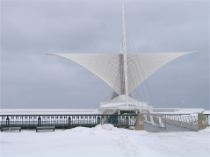
Before the snow storm began last week my sister Cate and I, visiting family in Milwaukee, actually got out to see some art at the Milwaukee Art Museum. I’ve told you about the Santiago Calatrava addition to the museum in a previous post but since I just can’t get enough of it I’m going to treat you to a few more images and say a little about the art inside. (top image shows the moveable wings (brise soleil) of the building. They’re wide open — weather permitting, they open them each day.)
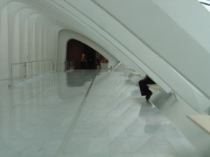 Here’s some “Fun Facts” about the building that came in my press kit.
Here’s some “Fun Facts” about the building that came in my press kit.
–Roughly 20,000 cubic yards of concrete were used (81 million lbs.). If the concrete were formed into a 1 x 1 sq. ft. column it would reach 102 miles into the sky.
–there are approximately 915 separate panes of glass. Fewer than 6 percent are standard issue window glass (flat panes). The other 94 percent are tilted, curved or both.
–An average-sized, two-story family home would fit comfortably inside the reception hall.
–One acre of Carrera marble was used for the floors. (image shows the marble floors and the rib-cage like hallway.)
–Comparing the MAM Calatrava to a Boeing 747-400, the MAM is longer (293 ft. vs 240 ft.) and has a wider wingspan (217 ft. vs. 211 ft.)
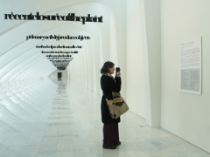
In what must be the museum’s project space housed in the Calatrava addition’s front (the Schroeder Galleria) there’s a site specific work by Liam Gillick, “Ovningskorning (Driving Practice, parts 1-30)” in which the British artist and writer made a word piece with 30 phrases to correspond with the 30 arches in the gallery. (image left is me taking a picture of the wall text. I do that sometimes when there’s no handout. It beats note-taking.)
The story, which was not linear as far as I could tell, had to do with an experimental Volvo car manufacturing plant in Kalmar, Sweden. The plant had a socialist-fueled, worker-centered approach to car making. The plant closed recently. I found the idea behind the piece poignant and fitting for Milwaukee, a place that used to be a manufacturing powerhouse (Milton Bradley, Pabst, Schlitz, Blatz — all those breweries, Allis Chalmers, etc.). Milwaukee, after loss of almost all its manufacturing base, (Harley Davidson remains) is now a tourism and service-industry town.
(image below is looking out a window at Lake Michigan. Did you know that inside the breakwater, the lake freezes?)
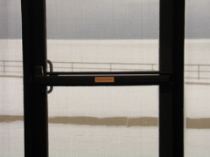
Speaking of art and tourism, while I was visiting, there was an announcement that the city’s tourism and marketing board had decided to adopt the Calatrava building as its signature logo for all advertising for the city. This makes sense for a building that is a signature building, a kind of Eiffel Tower destination. (Read more here and here.)
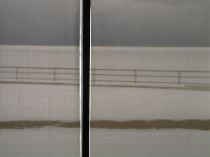 My hope is that MAM gets some dough out of the transaction. They gave the image freely in hope of generating more visitors to the museum. (The MAM, you may recall, is trying to dig out from under a $25 million debt they incurred when the Calatrava building went over budget.) (image is again looking out at the frozen water. Did you know the Army Corps of Engineers dug a navagation channel in the St. Claire River in the 1960s and it’s gotten bigger over time and is now considered responsible for Lakes Michigan and Huron “draining” away down the river into the Atlantic Ocean? The lake levels are down a foot. Read more.)
My hope is that MAM gets some dough out of the transaction. They gave the image freely in hope of generating more visitors to the museum. (The MAM, you may recall, is trying to dig out from under a $25 million debt they incurred when the Calatrava building went over budget.) (image is again looking out at the frozen water. Did you know the Army Corps of Engineers dug a navagation channel in the St. Claire River in the 1960s and it’s gotten bigger over time and is now considered responsible for Lakes Michigan and Huron “draining” away down the river into the Atlantic Ocean? The lake levels are down a foot. Read more.)Once outside the Calatrava wing we looked around the contemporary collection a little and spent some time in a travelling Mark Lombardi exhibit that we had almost given up finding and then stumbled upon while on our way out. I’ll tell you more about that in another post. Here’s a shot of a piece in the contemporary wing, a place with so many great pieces on display it makes me cringe when I think of the stinginess of the fare available in the contemporary galleries in our own PMA.
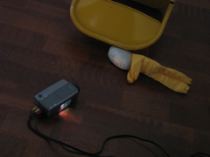
Tony Oursler‘s “MMPI (self-portrait in yellow),” 1996, is, like much of the artist’s work, sad, funny, angry, poignant and compelling. (image is detail) Oursler’s face is projected on the little yellow doll. He speaks ridiculous platitudes and cliches like “I never tell lies… Most people are fake… Animals are better than people.” The work was sited near two, large-scale blow-ups of film stills, one from Matthew Barney’s Cremaster series and the other from Shirin Neshat’s “The Rapture.” The triangulated arrangement with the three film/video makers was kind of spooky — like odd family portraits of dad (Barney) posing in a dress, mom and her friends (Neshat) pushing a boat into the water and baby (Oursler) caught under a chair after presumably doing some mischief.

I’ll leave you with this lovely sky picture taken from the air. The night was clear and the air was calm. The snow-covered ground looked like lace without a regular pattern.
And the planes, both Cate’s to New York and mine to Philadelphia landed early.









